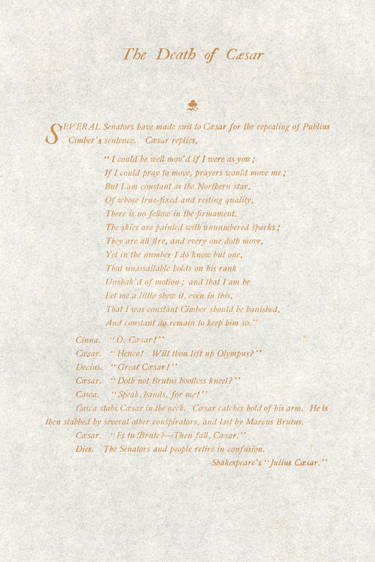These Humans Are Crazy - An Asterix essay
Deviation Actions
Literature Text
In other words: reasons why Asterix is a great, great comic, and definitely worth your time.
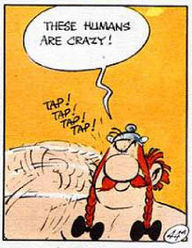
My personal history with this franchise is quite ancient. Over the many years I spent in its company, I met lots of people who had at least heard of it, but very few of them were familiar with the original series and its spirit. I thought it’d be nice to have a reference post about the general theme and the main elements of one of the most brilliant European comic series of the past century.
Asterix piqued my interest when I was almost too young to read, let alone understand it. Still, all phenomena of stellar popularity have a good reason behind their success, and it is usually the fact that they speak to us universally. They have a magic touch that is noticeable to everyone, regardless of their degree of understanding.
Needless to say, I only grew to appreciate it more and more. This comic is a masterpiece of fine satire – elegant and cared for to the smallest detail, but so seamlessly put together that the hard work behind it is barely noticeable at first sight. In favour of old and new readers, I am willing to do it justice.
Feel free to have a look, whether you belong to our small circle of dedicated fans or know nothing about it. Also, go ahead and link this post to anyone who might need it. It will be a long read, though – be prepared. Here we go!
Ancient eternal world. A bit of context
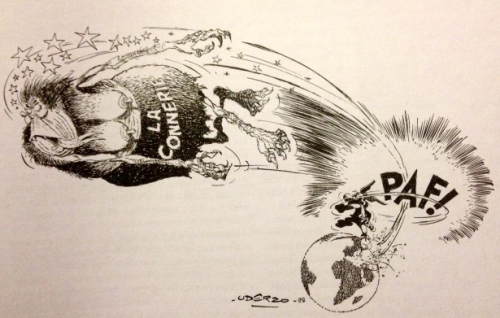
La connerie – Stupidity
Now, here is what you are probably asking yourself: is a comic book series really hilarious enough to make me want to spend thousands of words on it?
Of course it is. But it may not be – not without knowing the key to every single one of its jokes, aka the context it came to be in.
Asterix was created by two French gentlemen who had tons of talent, and a rare sense of humour running in their veins. By the time the dawning of the Sixties brought along their brainchild, René Goscinny and Albert Uderzo were already mature and experienced artists, forged by a long and difficult career of being rejected, starving and never giving up.
Their working conditions were finally favourable, as Pilote, which Goscinny had co-founded, was the first periodical comic magazine in France, and the first magazine whose editorial staff was formed by the contributors.
The greater freedom of choice they enjoyed, as well as the fact Pilote targeted young adults more than children, allowed the duo to take some crucial liberties which would mark the huge quality and success of their creation.
In an atmosphere dominated by American comics, superheroes and marketing procedures, Goscinny and Uderzo were asked to create a comic about French culture, so the readers could relate to it on a more immediate level. Sure enough, they kept their promise.
In terms of time, Asterix was set two thousand years earlier. But what the readers of Pilote – and later an extraordinarily vast public of readers – were offered, for the next few decades to come, was a parody of everything they could see around them. A parody of their time, morals and society, a parody of their country and the neighbour countries; a parody of fashion and news, a parody of their habits, their holidays, their money. Heck, even the Olympics became a good excuse.
The characters Uderzo’s pencil brought to life, with extraordinary talent, were the unwitting messengers of a writer graced by excellent observation skills and an unrepentant sharp tongue. The creators of Asterix explored the world around them incessantly, ever hungry for new cues and new concepts. The greatest thing about their skills, however, is the way they were eventually put to use.
At least in its golden age, the authors used their colourful display of mankind for a single purpose. Whatever the story, it always led to the same conclusion. Asterix is a crusade against human stupidity.
Dishonesty, envy, greed, prejudice – not a single human vice, great or small, escapes the ferocious humour of the creators. Goscinny loved writing his villains petty, and his people simple. The former, he could prove wrong with even more glorious results than cruel and inhuman villains; the latter were well-rounded and full of flaws, as even the best of human beings are. In between the two, while still part of the two, lies calm and rationality.
The ancient world of our comic is no more ancient than the one we lived in just yesterday. Regardless of time and space, the passions that Asterix explores with a naked eye are eternal companions of mankind. Which is why, despite its direct references to the years it was being written in, the comic seems to be suspended in time, and the circumstances are just a captivating side to a tasty dish of irreverent analyses which will never stop being true, as long as humans are there.
The message Asterix sends, behind all of this, is that pointless fears, superstition and selfish desires are the eternal plague of humanity. However, as long as it exists, they will also be part of its nature. And the creators never make us to wait long for the solution.
The best antidote? Knowing and resisting them. The best remedy? Outsmarting them.
Not all of Gaul. The setting
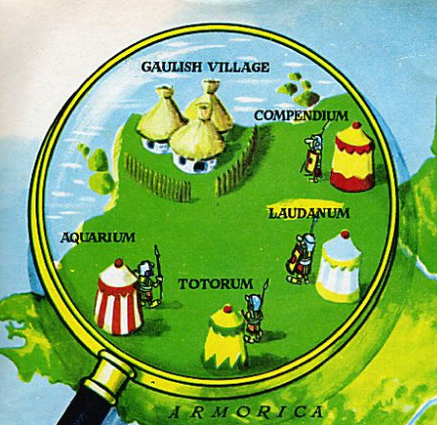
For a multi-layered message like this, which is incidentally sent to us with a monstrous amount of talent, the time and space our story takes place in may seem to be overly simple. I already said, however, that the context is but the stage for a merry comedy of errors, concerning the contemporary world and mankind in general.
Asterix is a satirical comic from the very start, and even the time setting of choice has an ironical aftertaste. There were not many direct documents about pre-conquest Gaul in the Sixties, and the most consistent source of contemporary info were Caesar’s Commentarii de bello gallico, which clearly couldn’t be taken as incontestable historical truth. Even so, Vercingetorix was seen as a symbol of patriotic resistance, and the young students of France kept hearing of the Gauls as their glorious and heroic ancestors (which is, funnily enough, what happens to us Italians with Romans).
It was a golden chance for our authors. Choosing Gaul in Caesar’s times would mean creating an ancient setting without fearing heavy criticism from scholars, while adding anachronisms on purpose and making fun of biased retellings – on both parts – of a still mysterious part of history.
This is how the context of Asterix came to be, and with it the only small narrative premise we will ever need to know.
In 50 B.C., according to Caesar, the Gaulish campaign is complete. What our comic tells us instead is that a nearly insignificant village, on the shores of Armorica (today’s Brittany), is not surrendering yet, and its inhabitants are not planning on doing it anytime soon. That this village would resist on its own would be unbelievable, if it wasn’t for the unforeseen trick up the old druid’s sleeve… the power of magic!
Yes, the magic potion which gives the villagers a superhuman force is a rare Franco-Belgian example of a, so to say, superpower. European productions usually shied away from American prerogatives, and superheroes and their world were one of them. But, besides its creators’ talent, their lack of adherence to what was considered the norm made the greatness of Asterix.
Let us meet, then, a few of the handful of Gauls which keep the otherwise invincible Roman legions at bay with the power of magic of their fists.
Heroes, or maybe not. The characters
There is no contradicting it: Goscinny was a really great fan of puns. Almost all of the character’s names are meaningful plays on words, and have been translated in countless versions to keep a similar meaning. For this post, I will make use of the English names, and put the French originals in brackets.
Asterix (Astérix)
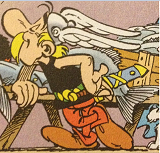
The procedure is simple. If the comic you are reading makes fun of stupidity, you expect the titular character to be a smartass. Right?
Right, more or less. As long as it is not meant in a bad way. Still, the best thing about the wonderful little man that serves as the first of the protagonists – because, as I will explain, he is not the only one – is that he was created to be the opposite of a hero.
I already mentioned the unconventional choices that, way far from breaking it, made this series and placed it in such a honorable spot. In the year 1960, the idea of comic hero was immediately linked to traditional US superheroes. It doesn’t take a genius to see Asterix is quite far from that, and far below, if you will.
As if his stature wasn’t enough, his name itself is there to tell us. Astérix, quite predictably, derives from astérisque, which has both a literal and etymological meaning. The asterisk is the symbol of a footnote, something small and crammed in a corner, which is often ignored. Taking a step backwards, the origin of both words is asterìskos, Greek for small star. His name doesn’t lie – he is definitely small, but also definitely a star. And his general attitude is both surprising and perfectly fitting.
Asterix is a warrior whose potential mostly lies in his mind. He doesn’t have out-of-average strength or battling skills, and definitely not an intimidating presence, as a delicious running gag keeps reminding us throughout the whole series. But the hilarity this small man awakens in any new enemy vanishes fast, and for more than good reasons.
In the company of a few others, Asterix has the difficult task of representing that balanced and rational mindset which keeps damaging attitudes away, and often neutralizes their effect. Which is an essential notion to understand why his obviously exceptional cleverness, shrewdness and ability to foresee people’s behaviors are not accompanied by a boundless ego. In the end, vanity is the first thing that intelligence chases away; and the series often shows that, if our little warrior weren’t as humble and cautious as he is, his astute plans would inevitably backfire or never even come to light.
But it is the lucky mixture of his character traits to ultimately make him a true and believable hero. His sharpness of mind taught him that the greatest danger people can find is within themselves, and in the capricious nature of desires that aren’t that meaningful at all. Even so, Asterix is a moody, fun and loving character, with simple habits and a complete ability to fail. He is deeply human. That is a luxury perfect comic heroes cannot usually afford, and yet it makes all the difference in the world.
All of this is shown in small details here and there, which is why his characterization is so refined and effective all throughout its evolution. A small example: the uncontested savior of the village, whose skills range from hunting boars to holding scarily manipulative speeches, is often seen tending to house chores with a lovely little apron. It’s one of those wonderful tiny things and I love it to bits.
We couldn’t ask for a better protagonist than an extraordinary little man like any and no other.
Obelix (Obélix)
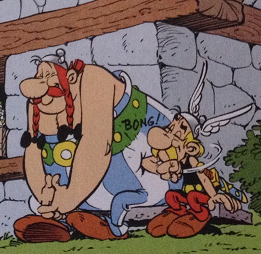
This comic is built in humour and exaggeration, but also in overthrown stereotypes which all go together in some way. Well then – if Asterix is not an unearthly, perfect hero, his best friend could not be a brainless mass of muscles.
That caring, sweet and simple Obelix would also be stupid to the marrow of his bones is one of the most common misconceptions, actually, and I wasn’t glad to see it endorsed by canon itself on some rare occasions. While he isn’t the brightest man around, the running gag of him not getting things is hilarious because of different reasons altogether.
All the characters in these series endure the lively and unpredictable fate of being created for laughs and, at the same time, having a complete personality. This choice is neither impossible, because it passes the readers’ test with flying colors, nor out of place, because it fits the double nature of the series itself – a series of monstrous intelligence, masked by its crisp, silly facade. You know what this choice really is? It is unusual. You shouldn’t be surprised at this point.
From his role to his personality, Obelix is a chain of adorable surprises, which no one could possibly ever dislike. Let’s look at some of them.
Everyone has a role in this parody of the world. By all means, Obelix is far from being a humour-oriented sidekick with no personality. He has a great symbolic and emotional role, because he is the incarnation of naivety and simplicity.
Obelix is no different from an overgrown child. In some way, he lives in a world of his own, and measures the events and people that surround him with a thought process that only belongs to him. However, behind the paradoxical comedy that his relationship with the world is, we cannot miss the two elements that are the key to understanding him.
First off: Obelix is extremely sensitive. He gets in touch with the world through his gut feelings, we may say. What bothers him has to go without a second thought; yet, he is ready to defend whatever and whoever he loves at the cost of his life, also without a second thought. This part of his nature directly causes the second element we are analyzing – his thought process is linear, and deeply intuitive.
It goes without saying that Obelix’s presence in the story would not be so noticeable, if it weren’t of essential importance. His simplicity helps him see the obvious; and when Asterix misses it, used as he is to overly complicated games of foretelling and planning, he is the only one who can give resolution to the story. On the other hand, Obelix also fulfills the delicate task of giving his friend a strong and unconditional support.
Without his constant company and boundless affection, Asterix would lack the entirety of the emotional back-up he needs – and it is not a negligible need, as his position in the village, which he didn’t even chase after, often forces him into situations of great pressure. Their friendship gives Asterix someone to confide in and to vent at, without fearing any consequences. Obelix, as the creature of feeling he is, gets someone to reassure and support him constantly in return.
In this sense, while they maintain a strong individual identity, they are complimentary characters that cannot work properly without each other. Their fraternal bond is so deep and so frequently represented that it gradually grew to be an outlier in the series first, and then the whole genre. tl;dr they are adorable and there is even a symbolic meaning to it. how cute is that. save me.
Touchy, grumpy, sensitive and caring, full of unexpected talents, shy and a true gentleman with the ladies – with a giant heart of gold overall, Obelix is, in ag47silver’s words, the best friend anyone could possibly have.
Dogmatix (Idéfix)

A stereotype that was never meant to exist. Dogmatix is so much more than that, in the end.
Sure, he was born as a running gag for a single album, and only ended up never leaving because the readers of Pilote did not fail to notice him. The authors originally meant to avoid giving pets to their heroes. However, they decided to keep him anyway, and he grew to be a character in every sense. Without him, we all would feel something is missing.
Idéfix means exactly what it looks like. A fixed idea. And, without a doubt, I would put him on par with Snoopy for “comic dog with the strongest personality ever”, with the addendum that we cannot even see Dogmatix thinking, if not in extremely rare side-stories. He is a dog in every way, except for his personality.
Hilariously small for his gargantuan master – because his owner, always against tradition, is not Asterix – Dogmatix’s body occupies a space that is inversely proportional to the one his character fills up. His features tell us countless things about the way he is, and it’s not surprising to find he is similar to (and shaped by) his two constant companions. As grumpy and sweet as Obelix, as sharp and quick as Asterix, a lover of good food and laughter as both.
He is also a lot more things, but I won’t spoil them. The pleasure is in the reading.
Getafix (Panoramix)
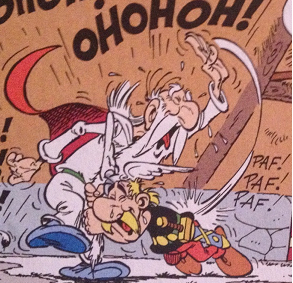
Druid of the village, local hero, and, quite predictably, the incarnation of wisdom.
Getafix is, all things considered, a more linear character than the average. Then again, he is not less fascinating in the slightest for that. As I said several times already, every main character in Asterix has an important role to fulfill.
Naturally, the role of this likable, clever and sometimes distracted old man is that of cultural pillar of the community.
If Vitalstatistix, the chief, keeps the village together with his political authority, Getafix represents the Gaulish equivalent of scientific knowledge. Funny, for a knowledge based on magical artifacts and potions. He has the curious task of joining a magical mindset with the rational, attentive and ever self-critical scientific method of today.
Now that we described the three of them, a little footnote is needed. In the light of their defining traits, we can clearly notice that Asterix, Obelix and Getafix are the odd bunch in a well-defined social group with well-defined norms. Their respective mindsets are different from each other, and sometimes criticized, but it is their untarnished originality to truly keep the village safe. The legionnaires may often be portrayed as brawl-bait, but very few of the Roman antagonists that come along over time are clueless fools, and Caesar definitely isn’t one of them. If the potion gives superhuman strength, the series is clear enough in showing it – without wisdom and intelligence, even its power would ultimately be useless.
So, if Getafix detains the secret of the potion alone, it is also true that his advice and his wisdom are equally useful. He is, in a way, an older equivalent to Asterix, who has more physical strength, but is more impulsive and less experienced (as I said, our little warrior tends to get mighty pissed, especially in the first albums, and is generally inclined to lose his patience quite fast for someone so clever.)
That they understand one another without much explaining, and nourish immense esteem and trust in each other, is definitely not strange. A strong sign of this, among others, is that they often team up beyond the chief’s authority, especially when it comes to giving their fellow villagers a good lesson. Which is the case for the picture I chose, coming from one of the most brilliant Asterix albums ever made. But he doesn’t lack faith in Obelix, either – and when someone rushes to save the day, it is usually the three of them together.
Cacofonix (Assurancetourix)

(I confide Tintin fans will remember the original version of this aria. Ah! je ris de me voir si belle en ce miroir…)
While Cacofonix rarely gets a main role in an Asterix story, he is worthy of being mentioned as a living example of its trademark paradoxical humour. In a society based on oral tradition, the bards belonged to one of the highest castes, as they forwarded the collective memory of a tribe with their knowledge. And who else could our village of grotesque Gauls could have, if not a tone-deaf, talentless artist?
There are two contrasting opinions about the one and only bard of the village –misunderstood genius, or complete disaster. And if the comic clearly shows that the second idea is shared by everyone except him, things are probably different in reality, as the pieces Cacofonix so passionately butchers are extremely successful songs or pieces from nearly two millennia in the future.
The authors merrily use Cacofonix as one of their most effective fourth wall breakers. He sings Gaulish versions of just about anything, from the Beatles to Charles Gonoud, from folk songs to Belgian songwriter Jacques Brel.
To be noted that, whenever younger characters meet him, they appreciate his cacophonies very much, in an evident jab at the revolutionary taste the French youths of the Sixties were proud of!
Vitalstatistix (Abraracourcix)

It is time to meet Vitalstatistix, the kindly and courageous chief of our little village. And, of course, the embodiment of the fickle nature of power, much more than of power itself.
While his authority is respected and recognized by the whole community, which contributes to a great deal of its safety, what our authors mostly love doing with this aging warrior is making fun of him in countless ways.
The notorious running gag of Vitalstatistix falling from his shield is just the tip of the iceberg. There is, first of all, the pointlessness of his chiefly choices, like the very act of being carried on a shield, or that of sitting on a rustic throne in the middle of his hut. With the same insistence he has on showing the symbols of his rank, the authors systematically destroy them. The poor chief is often forced to fall, slip, give speeches no one listens to, or hold diplomatic meetings while bathing or wearing his undergarments.
Vitalstatistix does his job, and he does it well. But whenever he indulges in the vainglory of power, the other characters are always there to burst his bubble. This task usually falls on Getafix or Asterix, who keep him at bay with both their words and their actions.
In fact, whenever they act against the conceited moods of their chief, the comic proves a point; it is their lack of ambition, more than their cunning and their reflective nature, to save them and the community from certain ruin.
In his own way, this little head of a little community makes a great parallel for the political power of Rome. The ultimate message is that, no matter the scale of the dominion, humans in command work the same way everywhere – they can only stay there if they have the ability to, and fall in the moment they get too arrogant.
Julius Caesar and his soldiers

When it comes to legendary historical figures, especially in a context of satire, there is a fine line between humanizing them and making them overly ridiculous. With Caesar, Asterix does an such an excellent job that the great Roman conqueror does not appear as the “villain”.
If the authors never tried ridiculing him, and let him retain the dignity and great abilities he deserved to have, they also didn’t make him a clichéd antagonist. Caesar is, more often than not, portrayed as a man great enough to retain the power he gained, but also humanly fallible, and growing old and tired.
The true villains of the series – if we can use this term for such an unconventional comic – are the people he turns to, attempt after attempt, in the hope they can succeed where he failed. This is where, in Asterix, we can find people doing evil for the sake of success, and through the lowliest means – like it happens in Asterix and the Roman agent (La Zizanie), my personal favourite adventure.
There are a good number of characters of this sort, whether they are direct antagonists or not. They are usually petty, immoral and undignified men, whose plans, no matter how astute, end up backfiring because of their arrogance. Unsurprising, given what we just said. Centurions who turn against the superiors to earn a glorious future, confident deceivers, or traitors who are full of themselves – the true antagonists of the Asterix universe are all joined by the fact that they do not recognize their own limits.
The greatest danger lies in the few of this lot who are clever enough to keep control of themselves. This is the case for La Zizanie, or for the fortune teller from another album, who gains the favor of almost the whole village by picturing the inhabitants’ futures exactly the way they want them to be.
And this is where Asterix becomes essential, because the one way to win against them is being better than them at their own game. These foul elements play on the Gauls’ human weaknesses – and if no one had ever seen through their lies and played on the enemies’ own raw nerves, the village would have been enslaved long before the series occurred.
The legionnaires, comic equivalent of one of the most powerful armies in history, are definitely closer to the ridiculous side. Even so, it is not a mean and degrading ridiculousness, even in this case.
Their cartoonish black eyes, inevitable gift of every battle, are countered by lovely domestic scenes in the military camps, where the soldiers are seen relaxing, playing dice or doing the laundry. The feeling is the same that occurs upon watching the Gauls’ lives go on in their home village.
The Asterix humour touches everyone, true villains excluded, in the same way – without mercy, but also with a lot of benevolence. It is full of the warm understanding that comes from the awareness we are all human, and actually all in the same boat.
What it takes. The authors

For the record, this standalone strip is about the creative process behind Asterix, and ends with the two of them being carried away in an ambulance. Consider these are the creators, and draw your own conclusions about this comic.
After telling you all you will ever need to know about the contents of this series, I want to spend just a few words about the artistic part. The great ideological content and the clever purpose of Asterix wouldn’t be nearly as effective without its spectacular writing and art.
By the time they created the series, Goscinny and Uderzo were bound by a strong friendship and a priceless common experience. On top of that, their sense of humour and opinions were extremely in tune, and their interpretations of the world through their respective fields were just made for each other. Which is why I don’t so much like it when Asterix is not made by them together, let alone by neither of them. The extreme quality of this comic is largely due to how well they understood one another.
Let us take a look, and study their respective contributions a little more in depth.
René Goscinny
Scarily talented scriptwriter, great lover of humour and plays on words, professional and extremely adaptable to the needs of every illustrator he was working for. René Goscinny was all of these things, and he never, ever disappointed.
His excellent mastery of words was the foundation on which his flawless characterizations and his great plots were built on. However, the results of his work could not depend just on that. He was a man of extraordinary culture and intelligence; he was ever hungry for knowledge and inspiration, which he got by reading, watching films, learning, and discussing all of it with his colleague. I don’t need to specify that much of it came from the world around him – the cynic eye that analyzes and explains humanity in Asterix is mostly his own.
For the sake of brevity, I am going to resort to something I wrote myself in another occasion.
The greatest merit Goscinny had, in my opinion, was his extraordinarily observant nature. He wasn’t just a great writer because of humour and wit; he was a keen critic of his time and of human nature in general, which allowed him to give so much depth to his characters in such a generally ridiculous context.
Albert Uderzo
Immense, immense illustrator. I don’t think my vocabulary has enough words to do his talent justice. In any case, it can never be praised enough.
His scripts, if still mostly good, clearly miss the spark of genius of his partner. But his art really had it all, and never lost a single shred of it. The best you can do to find out is read the comic yourself.
The light, dynamic style of Uderzo’s art has an expressiveness which is almost hard to believe. Animal or man, scenery, nature, he could always keep it extraordinarily elaborate and simple at the same time. Just the right amount of dynamic lines, and the perfect traits to express motion and emotion.
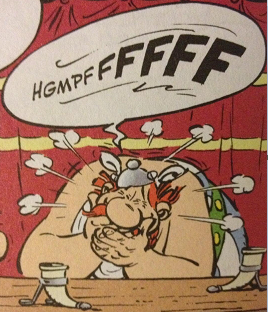
If the greatest Goscinny contribution that gets lost in translation is his writing, with untranslatable references and jokes, the Uderzo equivalent is that most of his lettering must go. It is to die for, which is why I only picked pictures with the original lettering, save for the first.
I cannot really put in words what is so great about his art. It is a mixture of fantastic things. Small visual running gags he added arbitrarily, pencils and inking so neat they don’t even look real sometimes, gorgeous liveliness. Take a look, especially in the albums of the Seventies, and you won’t be disappointed.
Are you sure you want more? The dark not-so-secrets you should know about
The following paragraphs express a strictly personal opinion. I will try to be as objective as possible, however, for the sake of clarity.
It was all fun and games, until René Goscinny died. Albert Uderzo was left with an immense personal loss to deal with, and the gigantic responsibility that the future of such a popular series represented.
He had to choose whether to go on or not. He did, and I am partially glad he did – some of his albums are really good. Even so, I feel like the spirit of the series was progressively lost. While Asterix is technically still being produced by two new artists, it is long dead to me. Inform yourself, and decide.
I am sure you get what I am saying, and leave the choice to you, aspiring readers. You decide what it’s best or your Asterix experience, but don’t venture too far, unless you are truly an enthusiast who is ready to see everything in ruins. Be wary around the Uderzo era, and most of all the newest albums.
Let’s get down to business!
If you are still alive at this point, great! You are strong. Here is the general info you need to read this comic.
The Asterix series is available in countless languages, so finding it should not be hard. It is comprised by 35 albums, with a new one coming (but keep in mind what I said). The first 24, until Asterix in Belgium included, are signed Goscinny-Uderzo. 25 to 34 are Uderzo albums only. Album 35, and the upcoming 36, are the work of Didier Conrad and Jean-Yves Ferri.
Disclaimer and thanks
I own none of the images in this post, which are all copyrighted by Hachette Livre and Éditions Albert-René. There are no lucrative purposes in their reproduction. I am not affiliated with any of the official Asterix publishers. The entire content of this post has informative purposes only.
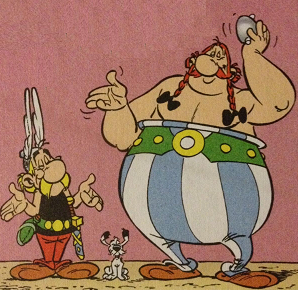
Thank you for bearing with me, really. I do hope this essay of epic proportions can serve as a useful resource. If I convinced you, don’t hesitate. Enjoy!
– altairattorney
What was meant to be an introductory post for aspiring Asterix readers became a twenty kilometers long essay. Handle with care.
I would be grateful if you warned me about any copyright infringements that do not fall under the category of fair use. I am ready to edit the pictures out of the essay anytime.
